IoT-Based Waste Management System in Formal and Informal Public Areas in Mecca
Abstract
1. Introduction
2. Background
2.1. Effect of Food Waste
2.2. Waste Management System in Mecca
- Waste is transferred in underground pipes with a range of 30 km beneath the central zone of Makkah;
- It is expanded to 7 km outside the Haram domain;
- The project permits the moving of 600 tons per day in more than 318 locations.
- In the first level, the capacitive nearness sensors split up papers and plastic into the trash bin, then check the papers and move them to part A whilst the plastic is transferred directly to Part B;
- In the second level, the metal sensor is utilized to check metal and transmit it to part C;
- In the third level, the IR sensor checks the glass and moves it to part D;
- In the fourth level, the remaining waste is moved to part E;
- Lastly, the ultrasonic sensor observes the scale of the trash bin fill.
3. Proposed Design
3.1. Waste Distribution Model
3.2. Waste Collection Strategy
3.2.1. Smart Collection Method
3.2.2. Manual Collection Method
3.3. Optimization Waste Collection Transportation
3.4. Waste Processing
4. Evaluation Results
5. Comparison and Discussion
6. Conclusions
Author Contributions
Funding
Institutional Review Board Statement
Informed Consent Statement
Acknowledgments
Conflicts of Interest
References
- Nizami, A.; Rehan, M.; Naqvi, M.; Ouda, O.; Shahzad, K.; Syamsiro, M.; Waqas, M.; Miandad, R.; Asam, Z.; Ismail, I.M. Energy, economic and environmental savings by waste recycling: A case study of Madinah city. Energy Procedia 2017, 142, 910–915. [Google Scholar] [CrossRef]
- Shambour, M.K.; Gutub, A. Progress of IoT research technologies and applications serving Hajj and Umrah. Arab. J. Sci. Eng. 2022, 47, 1253–1273. [Google Scholar] [CrossRef] [PubMed]
- Rehan, M.; Nizami, A.S.; Shahzad, K.; Ouda, O.K.M.; Ismail, I.M.I.; Almeelbi, T.; Iqbal, T.; Demirbas, A. Pyrolytic liquid fuel: A source of renewable electricity generation in Makkah. Energy Sources Part A Recovery Util. Environ. Eff. 2016, 38, 2598–2603. [Google Scholar] [CrossRef]
- Abdullah, N.; Al-Wesabi, O.A.; Mohammed, B.A.; Al-Mekhlafi, Z.G.; Alazmi, M.; Alsaffar, M.; Sumari, P. Integrated Approach to Achieve a Sustainable Organic Waste Management System in Saudi Arabia. Foods 2022, 11, 1214. [Google Scholar] [CrossRef]
- Osra, F.A.; Osra, K.A.; Jones, P.; Osra, O.A.; Suhartini, N.; Alzahrani, J.S.; Mirza, A.Z. Public Space and Solid Waste Facilities in Makkah. Arab. J. Geosci. 2022, 15, 957. [Google Scholar] [CrossRef]
- Majrashi, A. Development-induced displacement of informal settlements in Makkah, Saudi Arabia. Ph.D. Thesis, Universiti Teknologi Malaysia, Johor, Malaysia, 2017. [Google Scholar]
- Derbali, A.; Farhi, A. Demographic Analysis of the Makkah Province for the Purpose of Evaluating the Balance of the Urban System. Quaest. Geogr. 2022, 41, 49–65. [Google Scholar] [CrossRef]
- Bayounis, A.; Eldamaty, T. Applying Geographic Information System (GIS) for Solar Power Plants Site Selection Support in Makkah. Technol. Invest. 2022, 13, 37–58. [Google Scholar] [CrossRef]
- Lewis-Lettington, R.; El-Hefnawi, A.; Bajaj, M. Makkah City Profile. UN-Habitat. 2019. Available online: https://unhabitat.org/makkah-city-profile (accessed on 6 October 2022).
- The 16th Services Guide for Makkah Al Mukarramah Region, Grity for Statistics. 2017. Available online: https://www.stats.gov.sa/sites/default/files/makkah_al-mokarramah_region_en.pdf (accessed on 6 October 2022).
- Bagnied, H.; El-Damaty, T.A. Scientia Research Library ISSN 2348-0424. J. Eng. Technol. Res. 2022, 10, 1–14. [Google Scholar]
- Saudi Press Agency. The Landfill of the Holy Capital Municipality Receives More Than 68 Thousand Tons of Waste. Available online: https://www.spa.gov.sa/2265087/ (accessed on 29 September 2022).
- Saudi Press Agency. 37% of the Waste Wasted in Makkah is “Organic”. Available online: https://www.spa.gov.sa/2219953/ (accessed on 29 September 2022).
- Alharbi, A.B. Native Settlements in Makkah Al-Mukarramah Area and Factors Affecting Its Distribution. Adv. Anthropol. 2015, 5, 267. [Google Scholar] [CrossRef][Green Version]
- Daiem, M.M.A.; Said, N. Energetic, economic, and environmental perspectives of power generation from residual biomass in Saudi Arabia. Alex. Eng. J. 2022, 61, 3351–3364. [Google Scholar] [CrossRef]
- Opazo Basaez, M.; Ghulam Muhammad, S.; Arias Aranda, D.; Molina Moreno, V. A roadmap towards smart services in healthcare. Dyna 2015, 92, 22–27. [Google Scholar] [CrossRef]
- Adedeji, K.B.; Ponnle, A.A.; Abu-Mahfouz, A.M.; Kurien, A.M. Towards Digitalization of Water Supply Systems for Sustainable Smart City Development—Water 4.0. Appl. Sci. 2022, 12, 9174. [Google Scholar] [CrossRef]
- Wang, J.; Liu, C.; Zhou, L.; Xu, J.; Wang, J.; Sang, Z. Progress of Standardization of Urban Infrastructure in Smart City. Standards 2022, 2, 417–429. [Google Scholar] [CrossRef]
- The World Bank Group. Trends in Solid Waste Management. Available online: https://datatopics.worldbank.org/what-a-waste/trends_in_solid_waste_management.html/ (accessed on 7 September 2022).
- Chen, D.M.C.; Bodirsky, B.L.; Krueger, T.; Mishra, A.; Popp, A. The world’s growing municipal solid waste: Trends and impacts. Environ. Res. Lett. 2020, 15, 074021. [Google Scholar] [CrossRef]
- UN Environment Programme (UNEP). UNEP Food Waste Index Report 2021. Available online: https://www.unep.org/resources/report/unep-food-waste-index-report-2021/ (accessed on 31 August 2022).
- Yaagoubi, R.; Faisal, K.; Miky, Y. Land value assessment based on an integrated Voronoi-geographically weighted regression approach in Makkah, Saudi Arabia. J. King Saud. Univ. Sci. 2021, 33, 101557. [Google Scholar] [CrossRef]
- Baig, M.B.; Gorski, I.; Neff, R.A. Understanding and addressing waste of food in the Kingdom of Saudi Arabia. Saudi J. Biol. Sci. 2019, 26, 1633–1648. [Google Scholar] [CrossRef] [PubMed]
- Osra, F.A.; Ozcan, H.K.; Alzahrani, J.S.; Alsoufi, M.S. Municipal solid waste characterization and landfill gas generation in kakia landfill, makkah. Sustainability 2021, 13, 1462. [Google Scholar] [CrossRef]
- Ali, A.M.; Nawaz, A.M.; Al-Turaif, H.A.; Shahzad, K. The economic and environmental analysis of energy production from slaughterhouse waste in Saudi Arabia. Environ. Dev. Sustain. 2021, 23, 4252–4269. [Google Scholar] [CrossRef]
- Ouda, O.K.; Raza, S.A.; Al-Waked, R.; Al-Asad, J.F.; Nizami, A.S. Waste-to-energy potential in the Western Province of Saudi Arabia. J. King Saud. Univ. Eng. Sci. 2017, 29, 212–220. [Google Scholar] [CrossRef]
- EcoMENA. Solid Waste Management in Saudi Arabia. Available online: https://www.ecomena.org/solid-waste-management-in-saudi-arabia/ (accessed on 2 September 2022).
- Abdullah, N.; Alwesabi, O.A.; Abdullah, R. IoT-Based Smart Waste Management System in a Smart City. In Recent Trends in Data Science and Soft Computing, Advances in Intelligent Systems and Computing; Saeed, F., Gazem, N., Mohammed, F., Busalim, A., Eds.; Springer: Cham, Switzerland, 2019; Volume 843, pp. 364–371. [Google Scholar] [CrossRef]
- MetroTaifun. Mecca in Saudi Arabia. Available online: http://www.metrotaifun.com/automatic_solid_waste_collection_system/en/references/selected-references/724-mecca-reference.html (accessed on 7 September 2022).
- Elhassan, R.; Ahmed, M.A.; AbdAlhalem, R. Smart waste management system for crowded area: Makkah and holy sites as a model. In Proceedings of the 4th MEC International Conference on Big Data and Smart City (ICBDSC), IEEE, Muscat, Oman, 15–16 January 2019; pp. 1–5. [Google Scholar] [CrossRef]
- Dini, I. Bio Discarded from Waste to Resource. Foods 2021, 10, 2652. [Google Scholar] [CrossRef]
- Berry, J.B.; Otley, D.T. Case-Based Research in Accounting. In The Real Life Guide to Accounting Research; Lee, B.C., Ed.; Elsevier: Amsterdam, The Netherlands, 2004; pp. 231–255. [Google Scholar] [CrossRef]
- Creswell, J.W.; Creswell, J.D. Research Design: Qualitative, Quantitative, and Mixed Methods Approaches, 5th ed.; SAGE publications: Thousand Oak, CA, USA, 2017. [Google Scholar]
- Neuman, W.L.; Robson, K. Basics of Social Research; Pearson Canada: Toronto, ON, Canada, 2014. [Google Scholar]
- Thornhill, A.; Saunders, M.; Lewis, P. Research Methods for Business Students; Prentice Hall: London, UK, 2009. [Google Scholar]
- Wahyuni, D. The research design maze: Understanding paradigms, cases, methods and methodologies. J. Appl. Manag. Account. Res. 2012, 10, 69–80. [Google Scholar]
- Woodside, A.G. Case Study Research: Theory, Methods and Practice, 1st ed.; Emerald Group Publishing: Bingley, UK, 2010. [Google Scholar]
- Yin, R.K. Applications of Case Study Research, 3rd ed.; SAGE Publications: Thousand Oaks, CA, USA, 2012. [Google Scholar]
- Chaudhari, M.S.; Patil, B.; Raut, V. Iot based waste collection management system for smart cities: An overview. In Proceedings of the 3rd International Conference on Computing Methodologies and Communication (ICCMC), Erode, India, 27–29 March 2019; pp. 802–805. [Google Scholar] [CrossRef]
- Gupta, P.K.; Shree, V.; Hiremath, L.; Rajendran, S. The Use of Modern Technology in Smart Waste Management and Recycling: Artificial Intelligence and Machine Learning. In Studies in Computational Intelligence; Springer: Cham, Switzerland, 2019; pp. 173–188. [Google Scholar] [CrossRef]
- Anagnostopoulos, T.; Zaslavsky, A.; Kolomvatsos, K.; Medvedev, A.; Amirian, P.; Morley, J.; Hadjieftymiades, S. Challenges and Opportunities of Waste Management in IoT-Enabled Smart Cities: A Survey. IEEE Trans. Sustain. Comput. 2017, 2, 275–289. [Google Scholar] [CrossRef]
- Vitorino de Souza Melaré, A.; Montenegro González, S.; Faceli, K.; Casadei, V. Technologies and decision support systems to aid solid-waste management: A systematic review. Waste Manag. 2017, 59, 567–584. [Google Scholar] [CrossRef]
- Abdullah, N.; Al-wesabi, O.A.; Mohammed, B.A.; Al-Mekhlafi, Z.G.; Alazmi, M.; Alsaffar, M.S.; Sumari, P. Improving waste management system efficiency and mobility with efficient path MANET. Appl. Sci. 2021, 11, 11039. [Google Scholar] [CrossRef]
- Mak, T.M.W.; Xiong, X.; Tsang, D.C.W.; Yu, I.K.M.; Sun Poon, C. Sustainable food waste management towards circular bioeconomy: Policy review, limitations and opportunities. Bioresour. Technol. 2019, 297, 122497. [Google Scholar] [CrossRef]
- Lai, C.F.; Lai, Y.X.; Yang, L.T.; Chao, H.C. Integration of IoT energy management system with appliance and activity recognition. In Proceedings of the CPSCom 2012, Besançon, France, 11–14 September 2012; pp. 66–71. [Google Scholar] [CrossRef]
- Ramallo-González, A.P.; Bardaki, C.; Kotsopoulos, D.; Tomat, V.; González Vidal, A.; Fernandez Ruiz, P.J.; Skarmeta Gómez, A. Reducing Energy Consumption in the Workplace via IoT-Allowed Behavioural Change Interventions. Buildings 2022, 12, 708. [Google Scholar] [CrossRef]
- Papaioannou, T.; Dimitriou, N.; Vasilakis, K.; Garbi, A. An IoT-Based Gamified Approach for Reducing Occupants’ Energy Wastage in Public Buildings. Sensors 2018, 18, 537. [Google Scholar] [CrossRef] [PubMed]
- Hermsen, S.; Frost, J.; Renes, R.J.; Kerkhof, P. Using feedback through digital technology to disrupt and change habitual behavior: A critical review of current literature. Comput. Hum. Behav. 2016, 57, 61–74. [Google Scholar] [CrossRef]
- Anagnostopoulos, T.; Kolomvatsos, K.; Anagnostopoulos, C.; Zaslavsky, A.; Hadjiefthymiades, S. Assessing dynamic models for high priority waste collection in smart cities. J. Syst. Softw. 2015, 110, 178–192. [Google Scholar] [CrossRef]
- Cerchecci, M.; Luti, F.; Mecocci, A.; Parrino, S.; Peruzzi, G.; Pozzebon, A. A low power IoT sensor node architecture for waste management within smart cities context. Sensors 2018, 18, 1282. [Google Scholar] [CrossRef]
- Navghane, S.S.; Killedar, M.S.; Rohokale, V.M. IoT based smart garbage and waste collection bin. Int. J. Adv. Res. Electron. Commun. Eng. 2016, 5, 1576–1578. [Google Scholar]
- Medvedev, A.; Fedchenkov, P.; Zaslavsky, A.; Anagnostopoulos, T.; Khoruzhnikov, S. Waste management as an IoT-enabled service in smart cities. In Internet of Things, Smart Spaces and Next Generation Networks and Systems; Balandin, S., Andreev, S., Koucheryavy, Y., Eds.; Springer: Cham, Switzerland, 2015; pp. 104–115. [Google Scholar] [CrossRef]
- Hassan, H.; Saad, F.; Fazlin, N.; Aziz, A. Waste monitoring system based on Internet-of-thing (IoT). In Proceedings of the IEEE Conference on Systems, Process and Control (ICSPC), Melaka, Malaysia, 14–15 December 2018; pp. 187–192. [Google Scholar] [CrossRef]
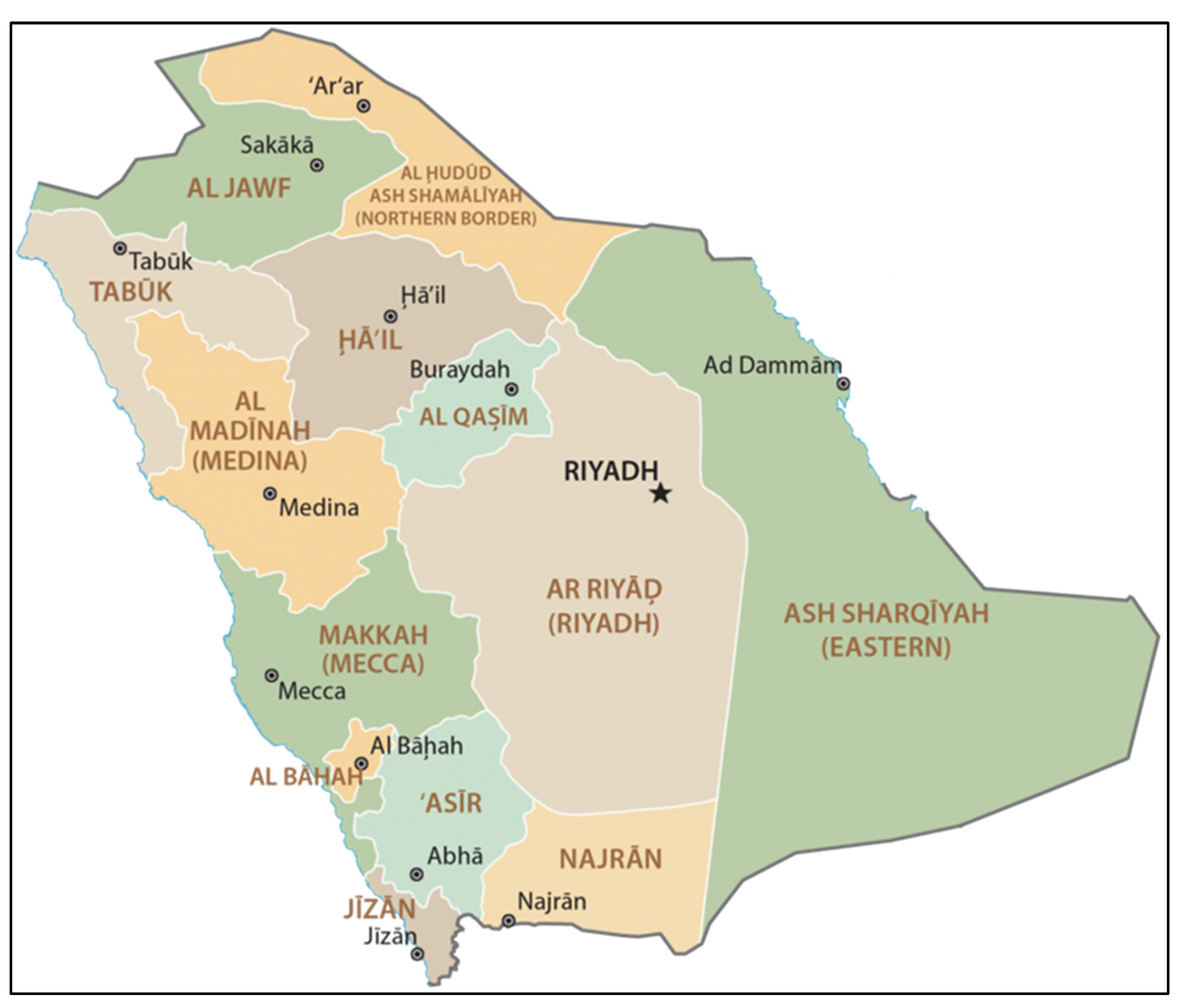
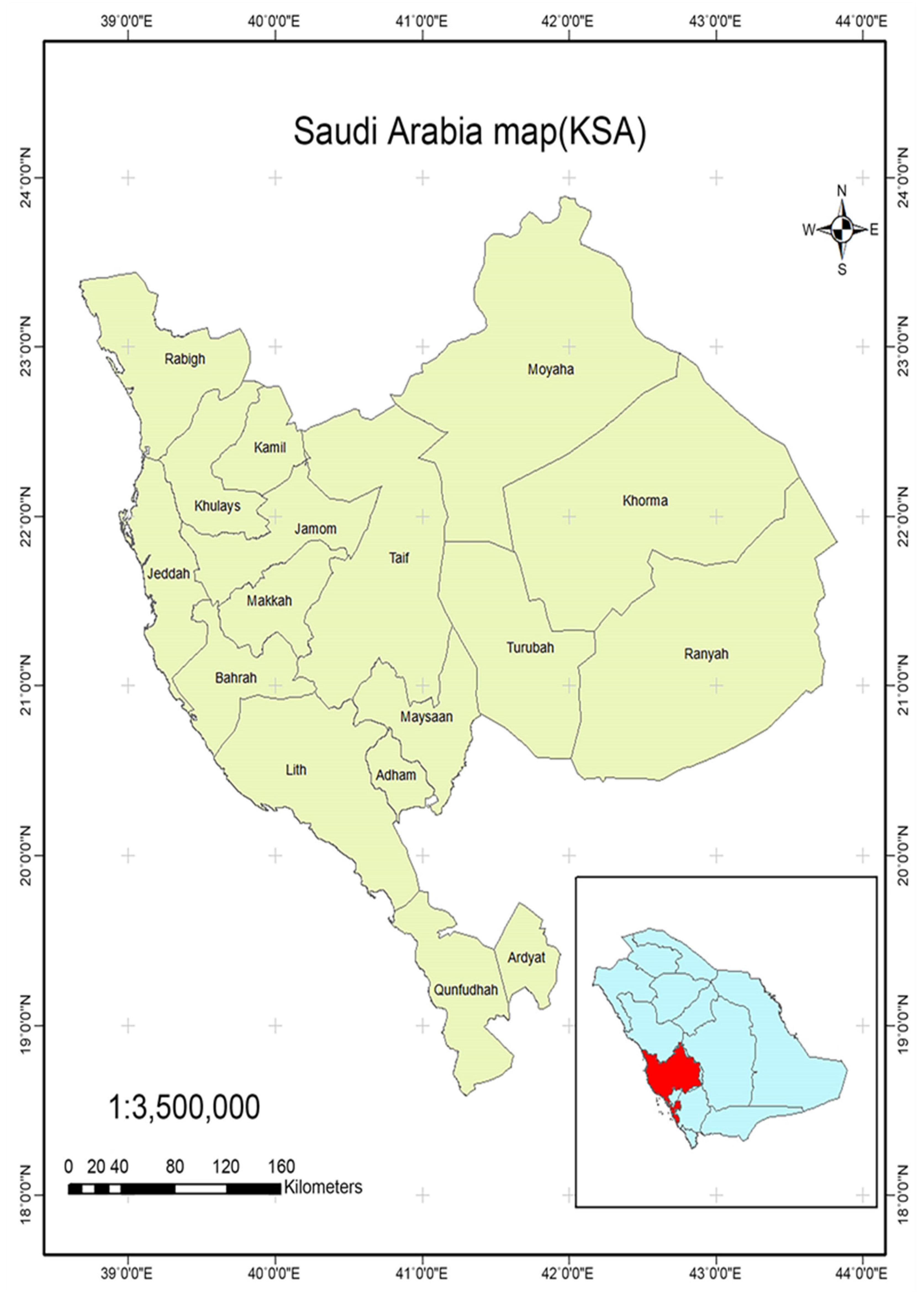
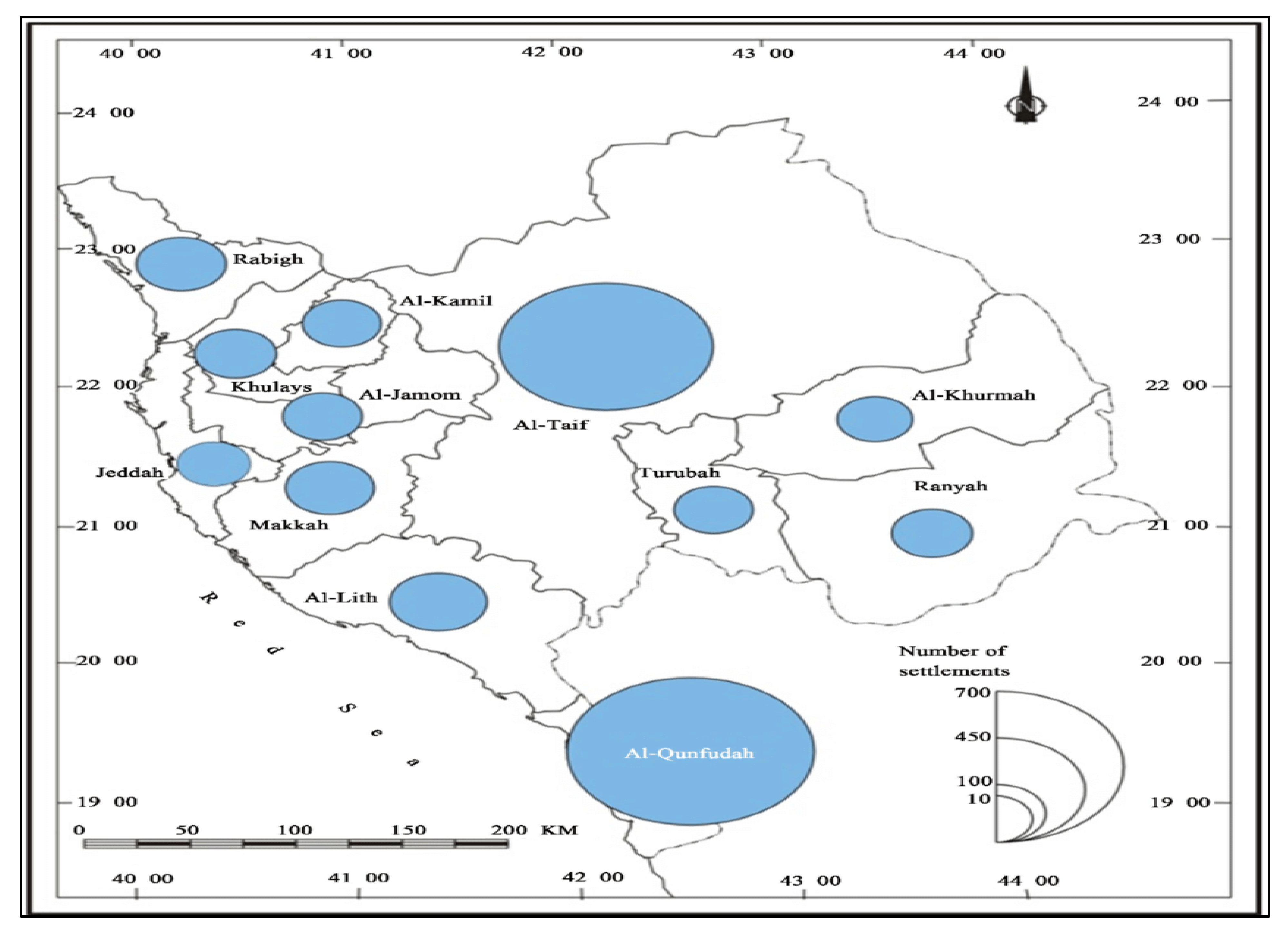
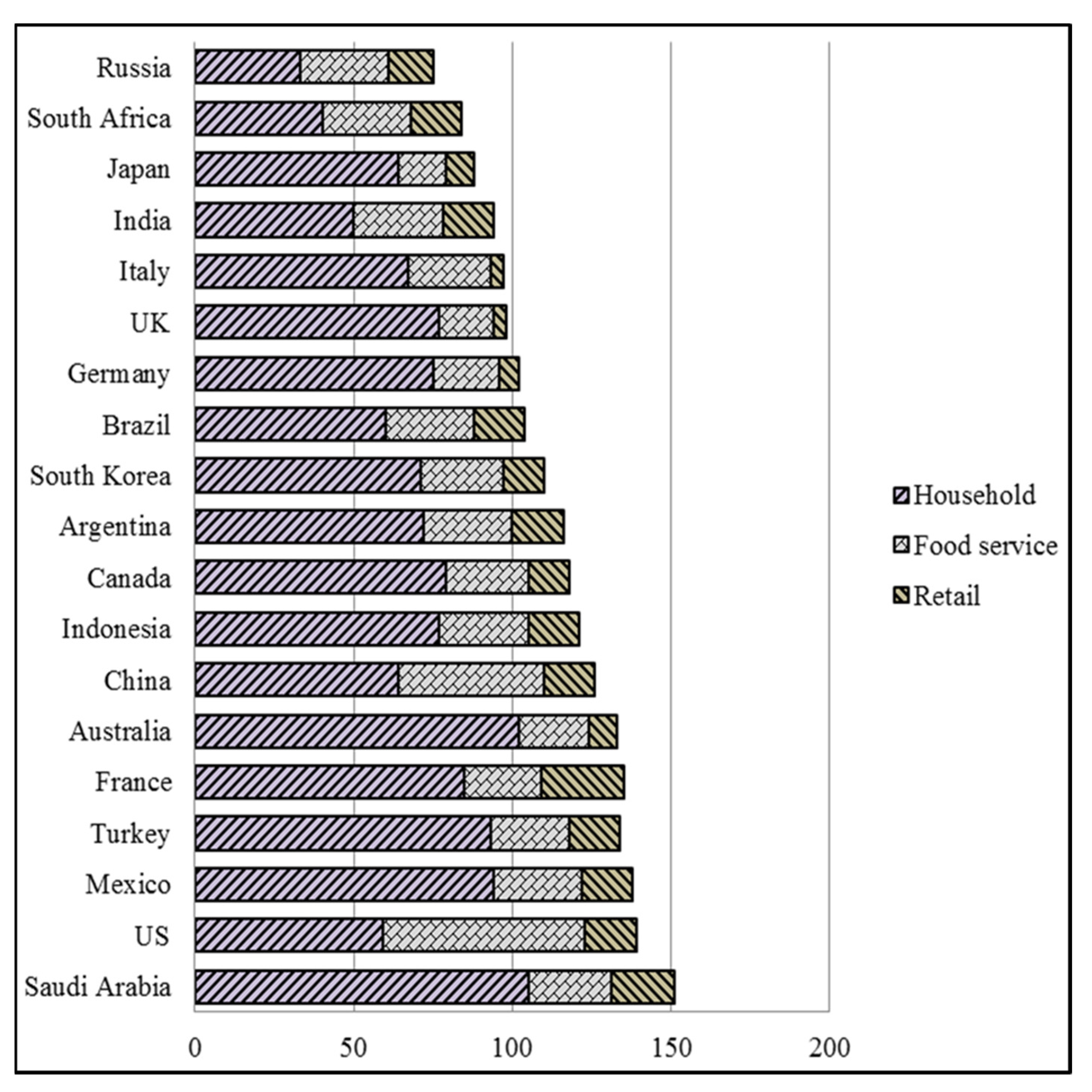

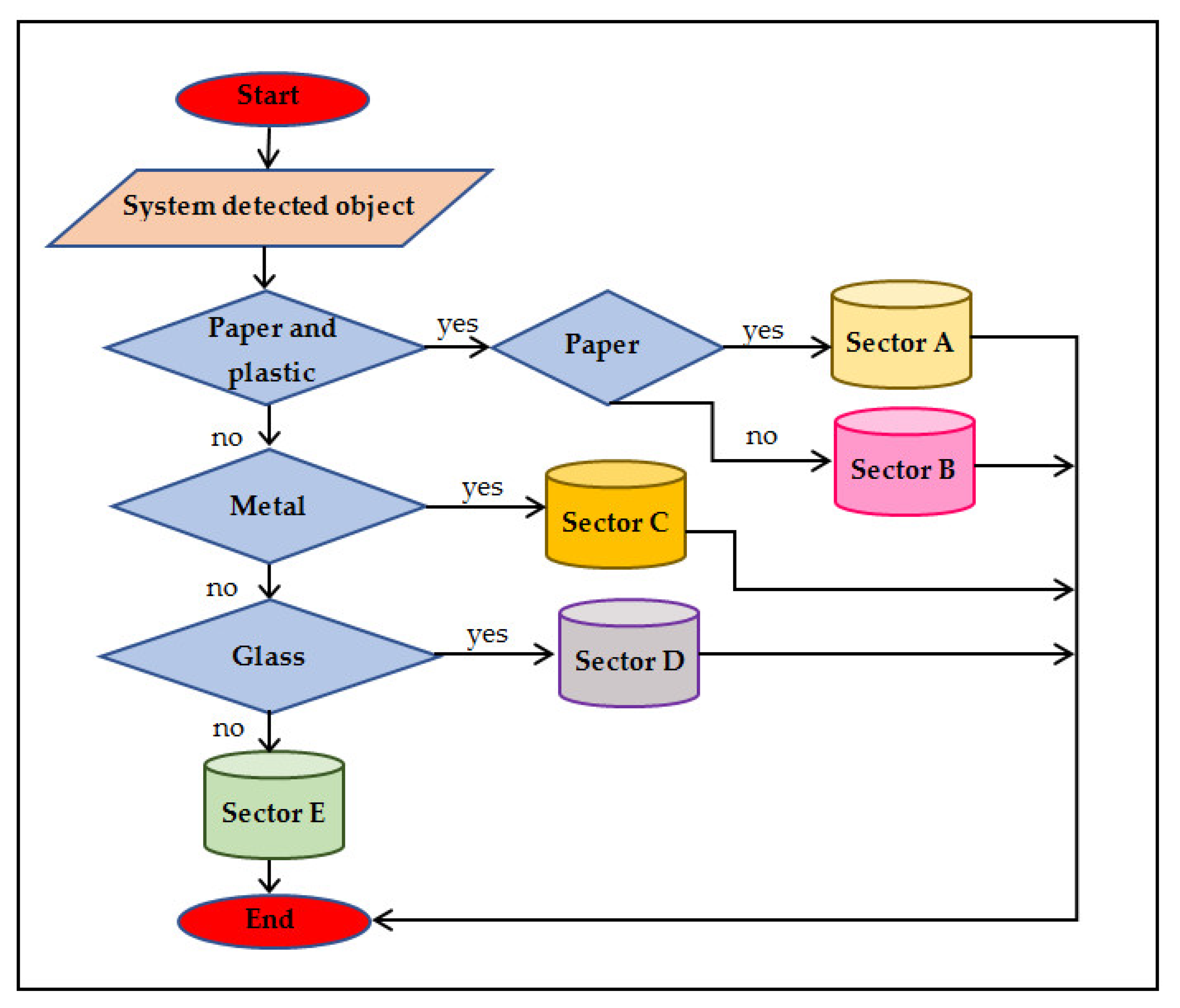
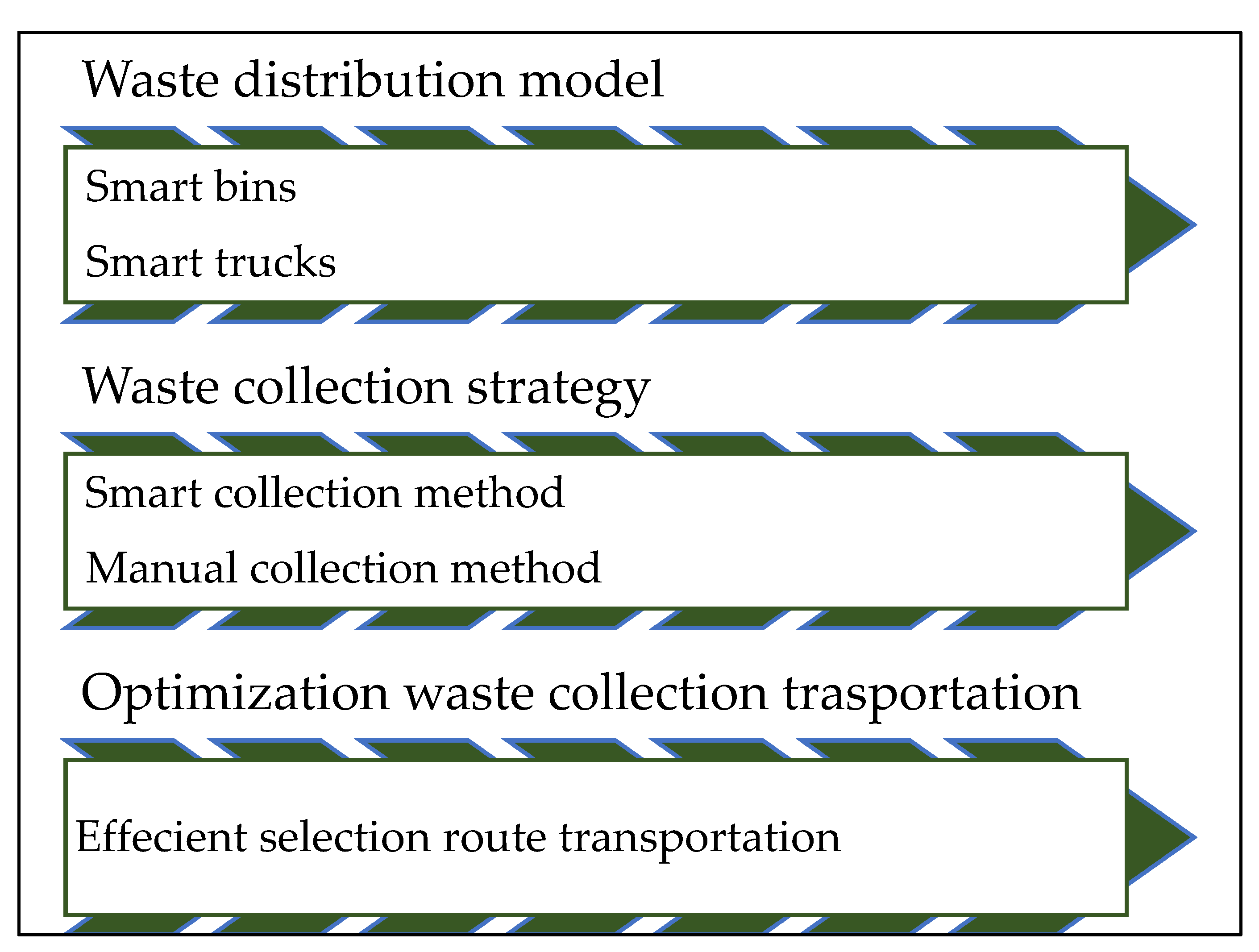
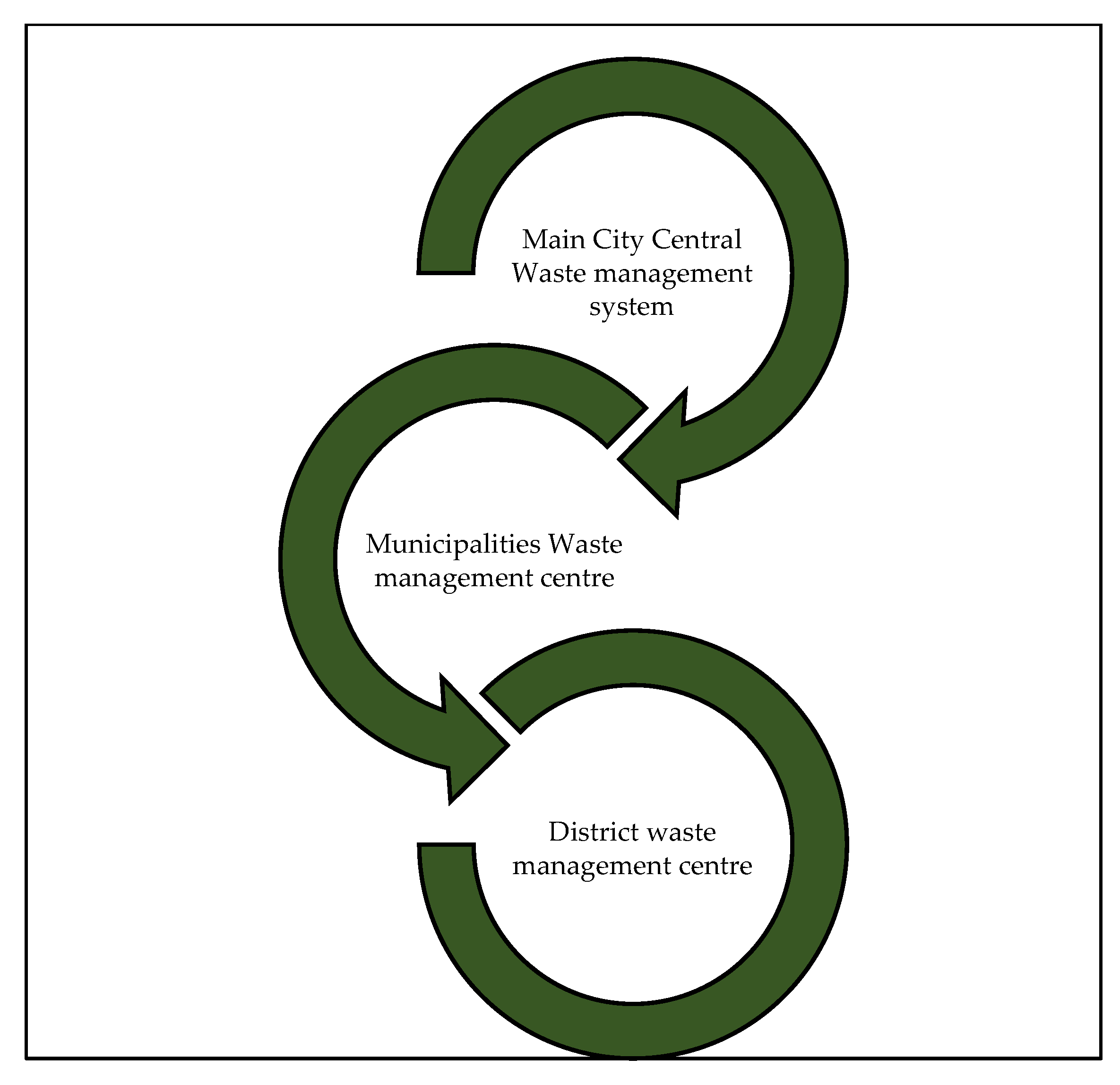
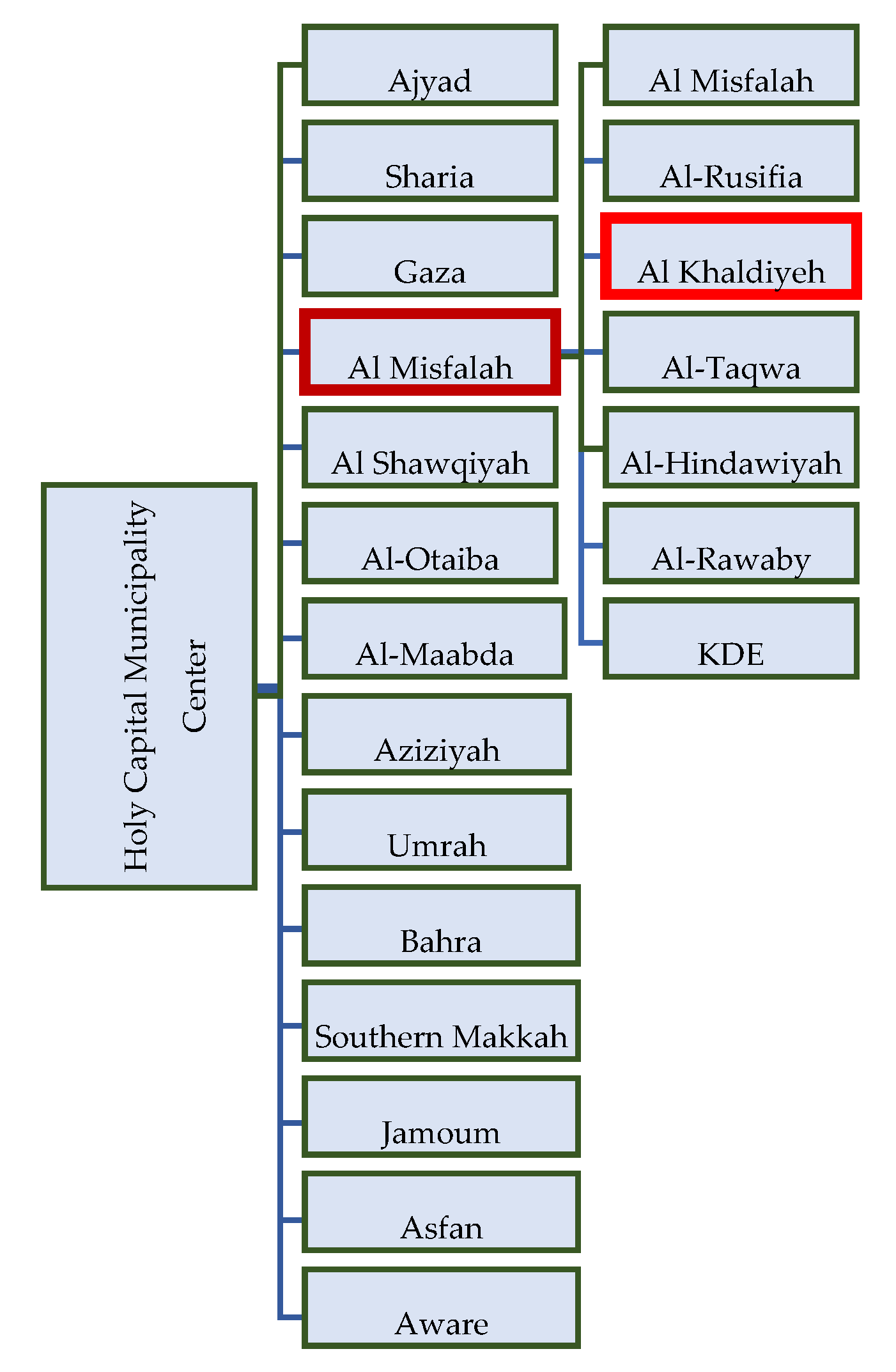
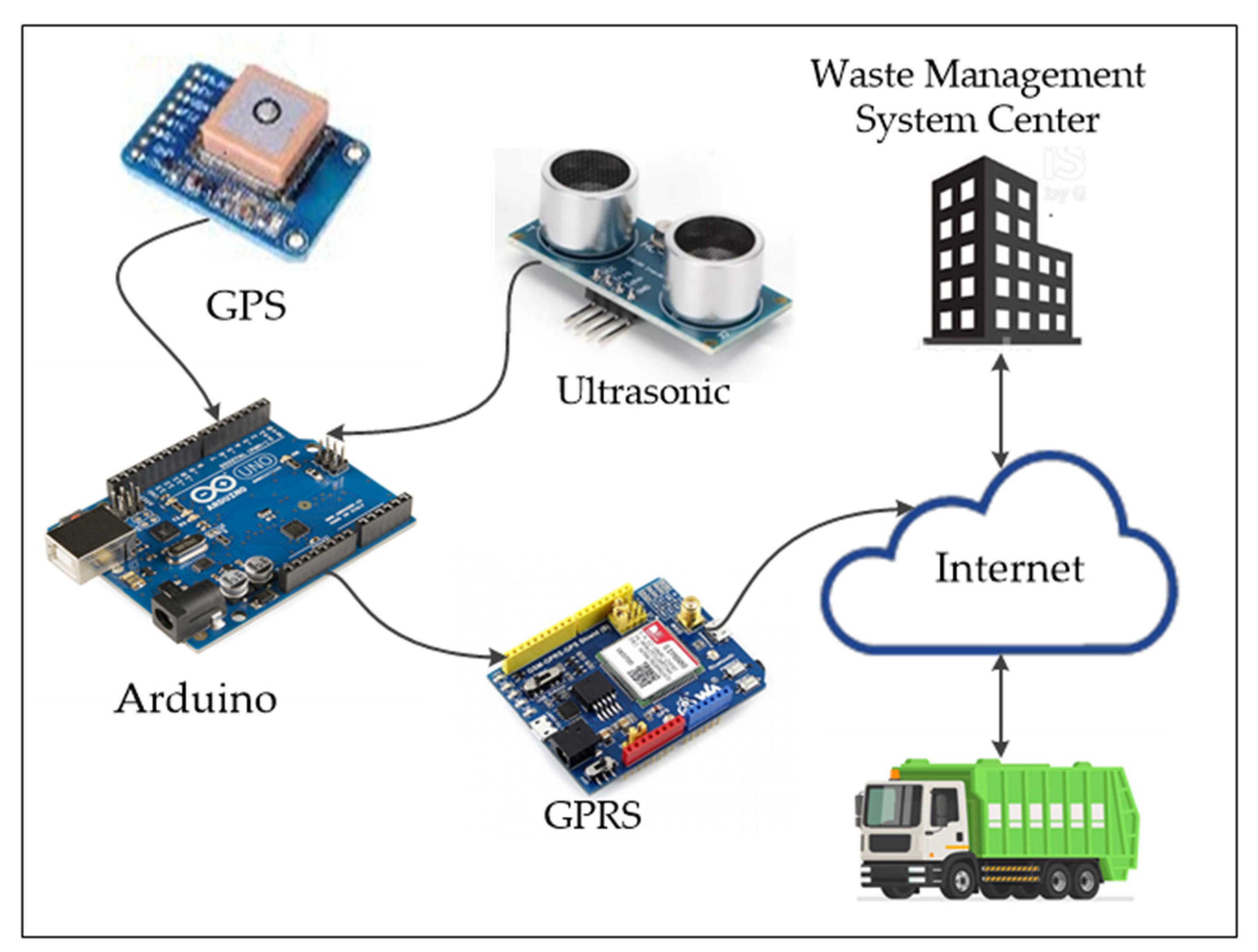
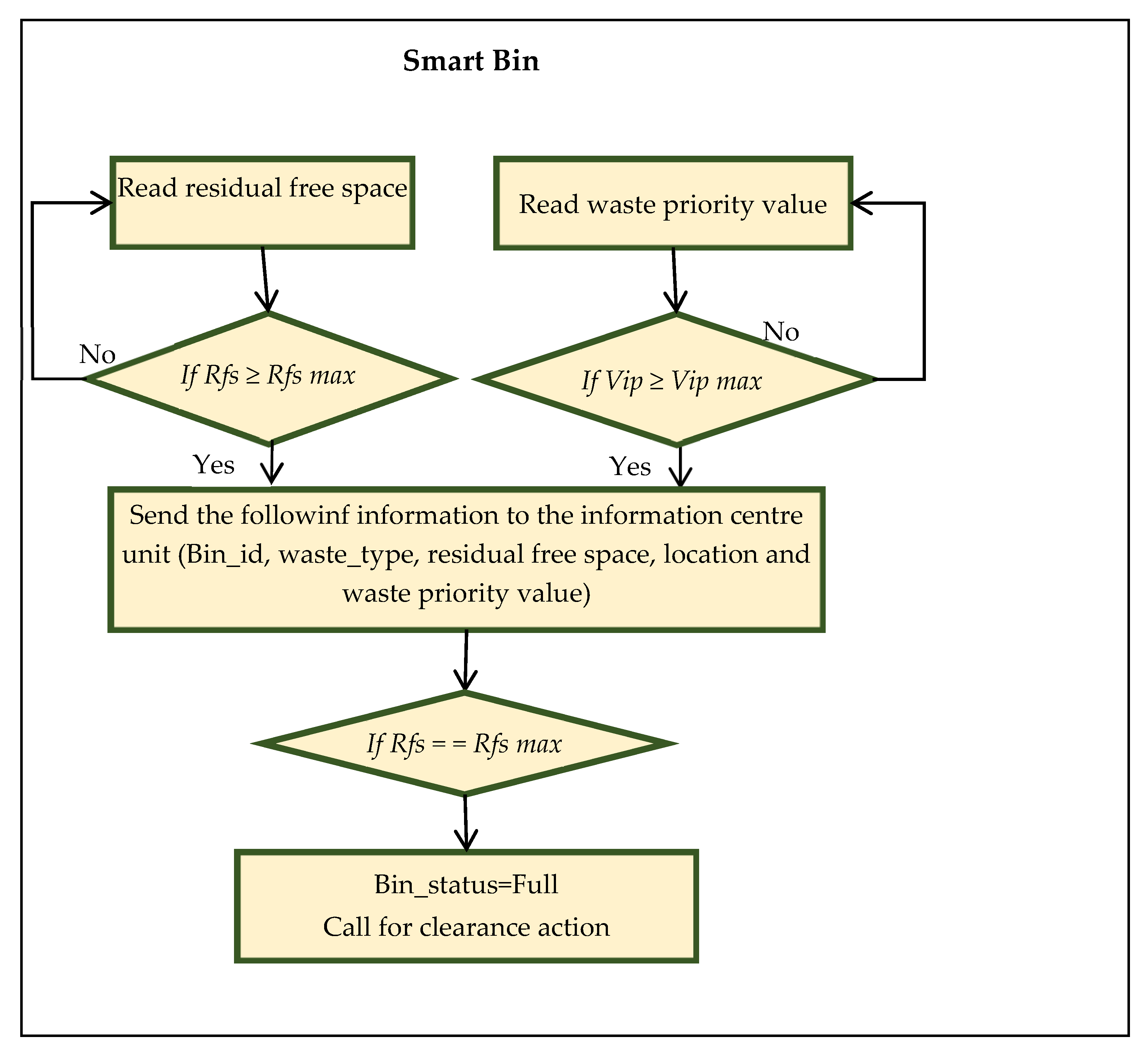
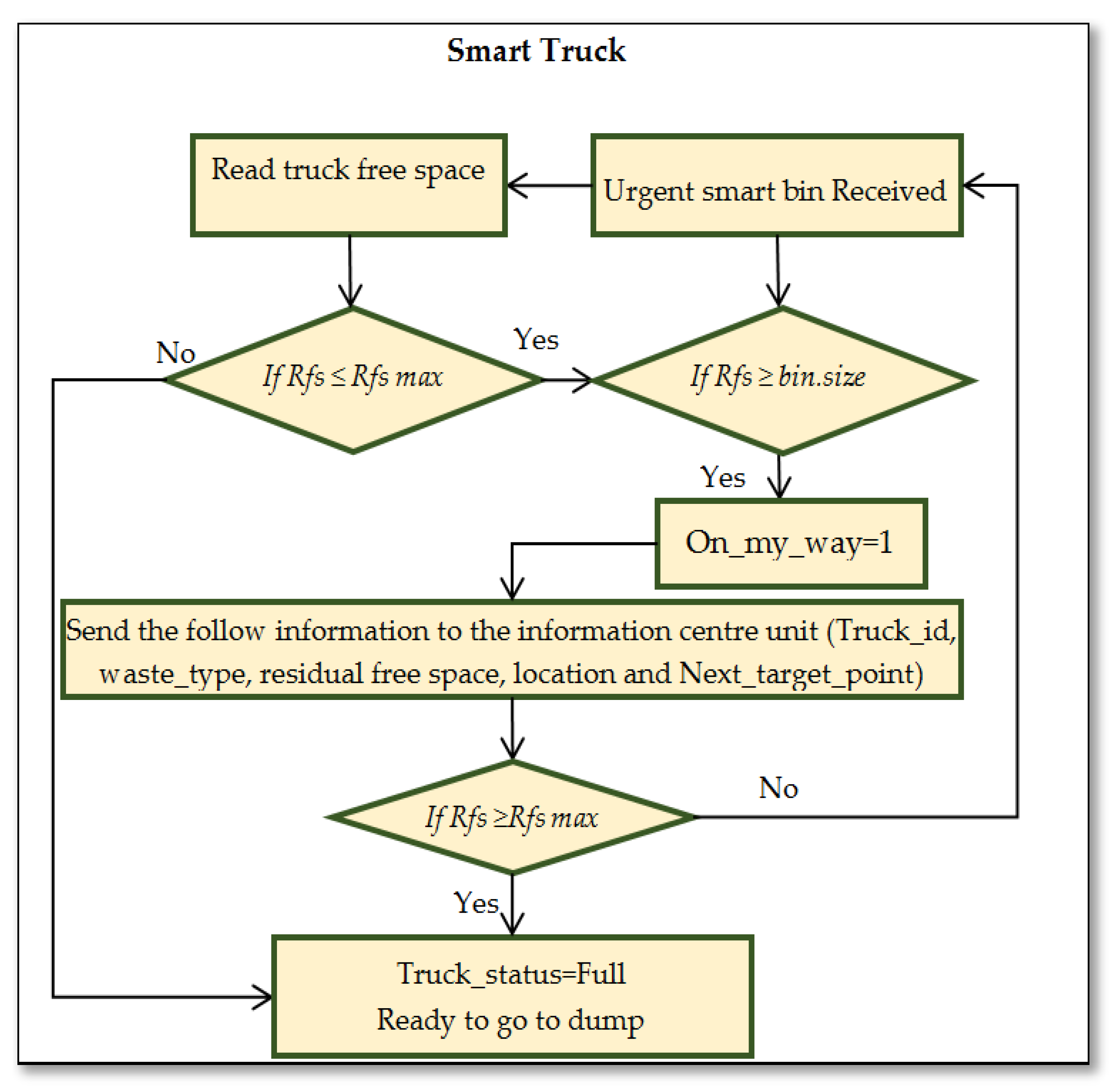
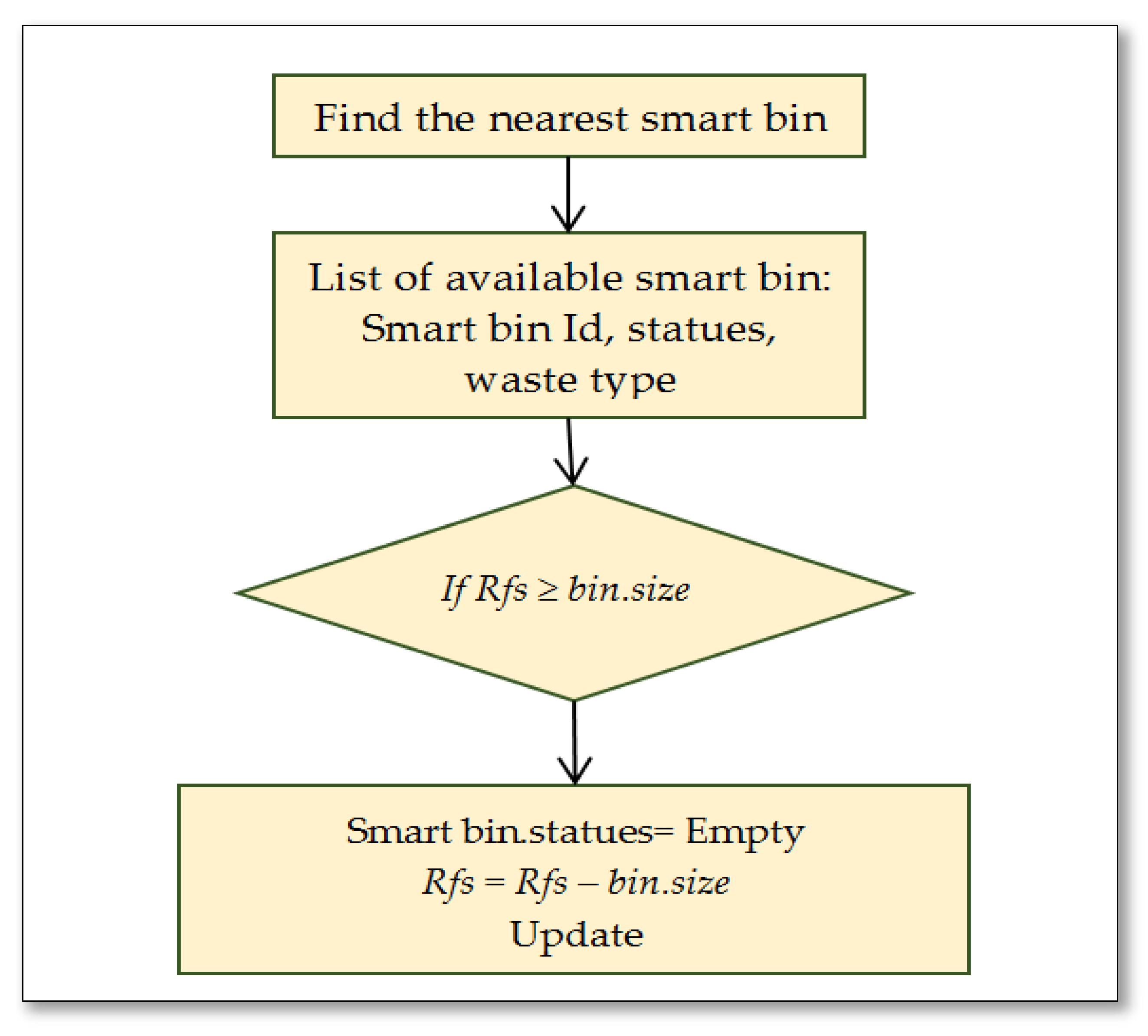

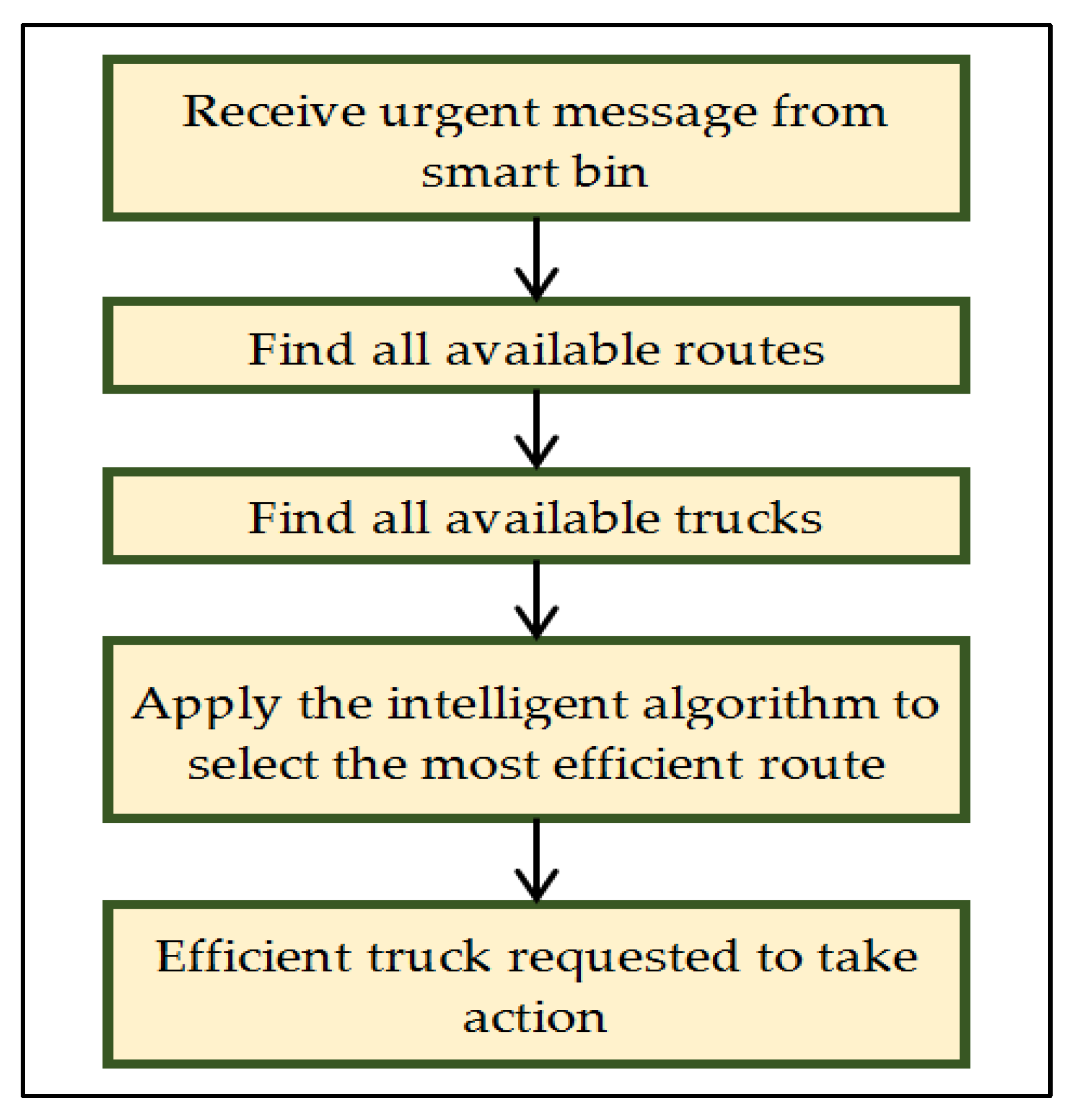
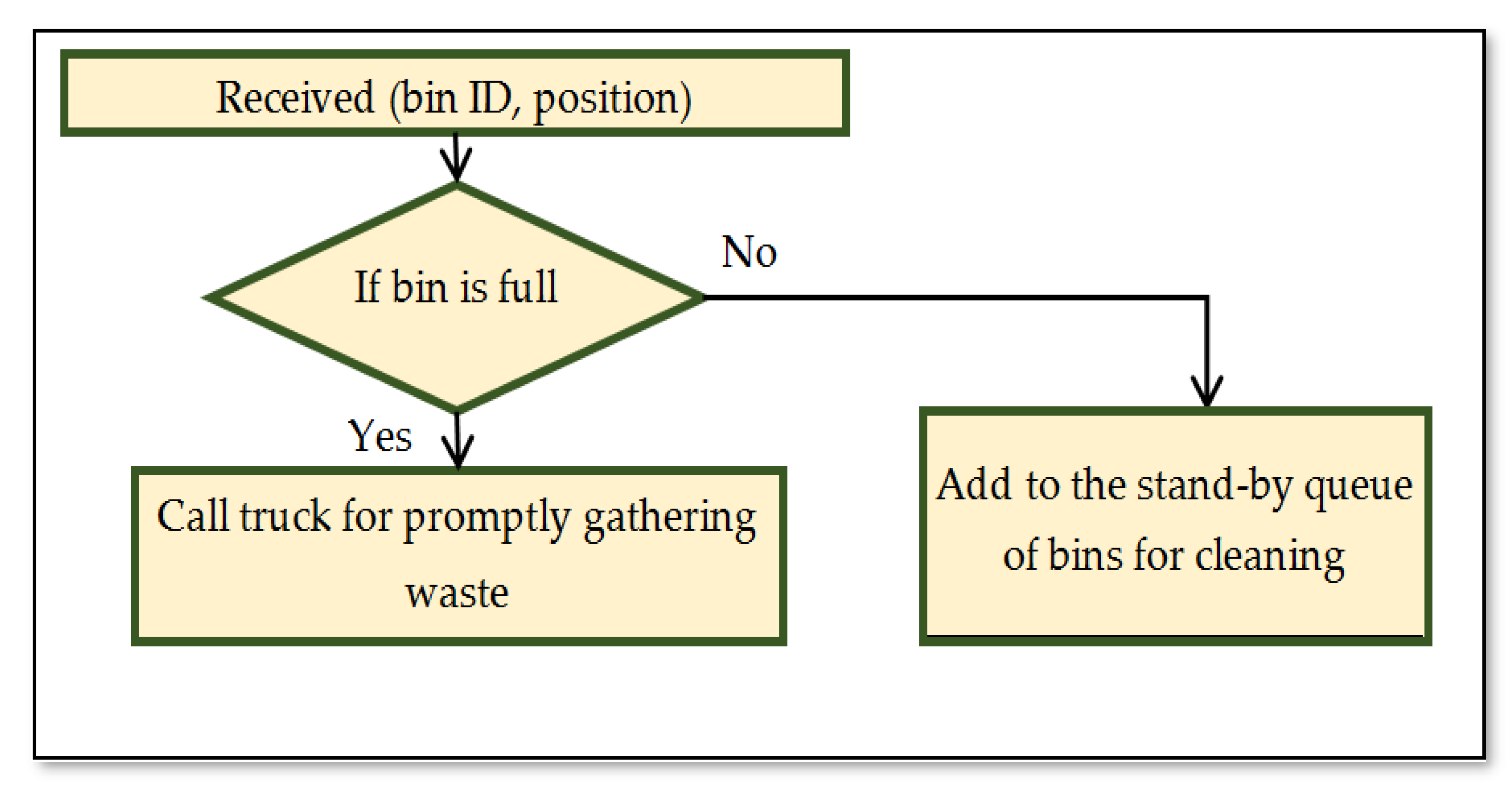
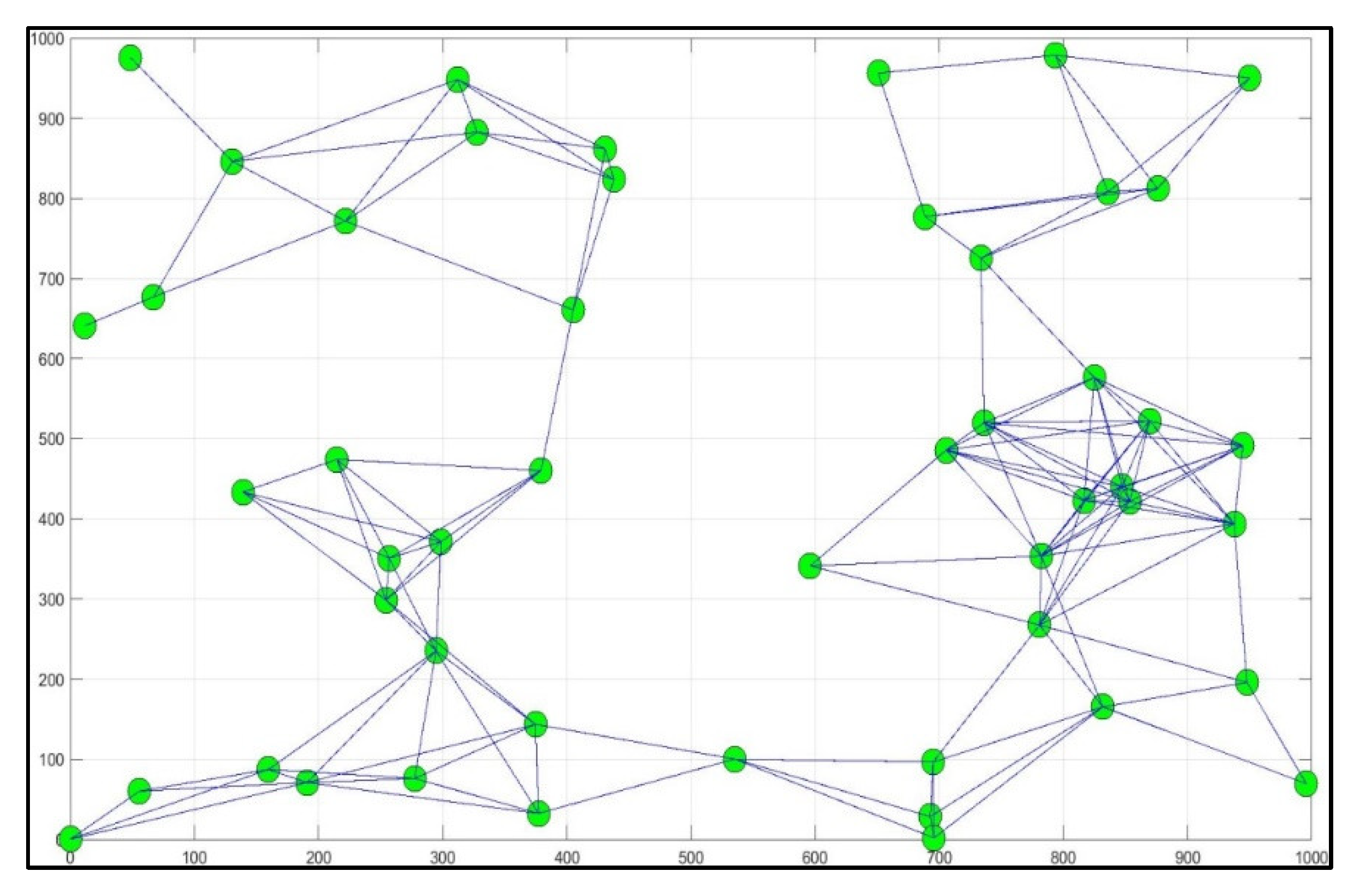
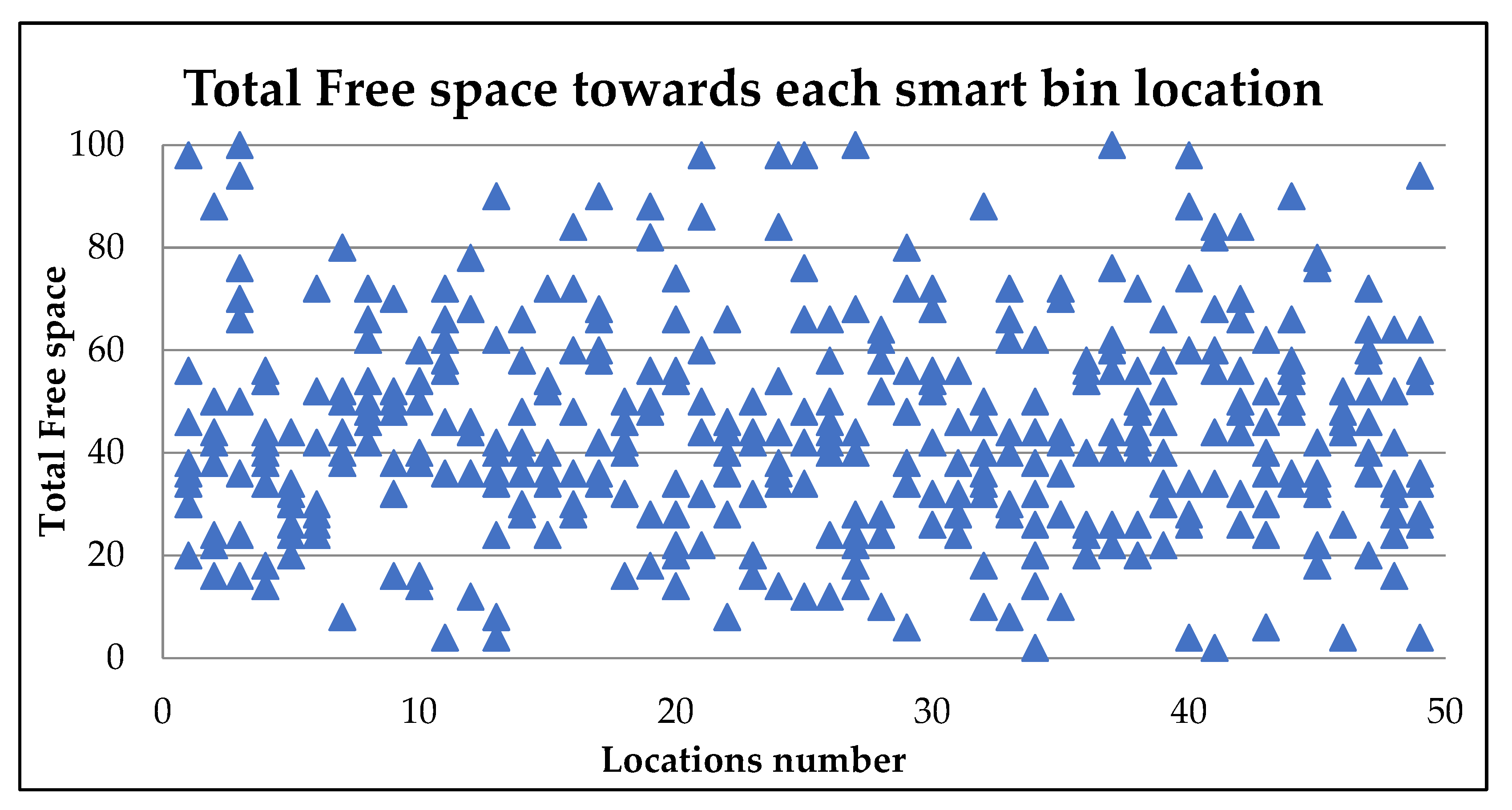

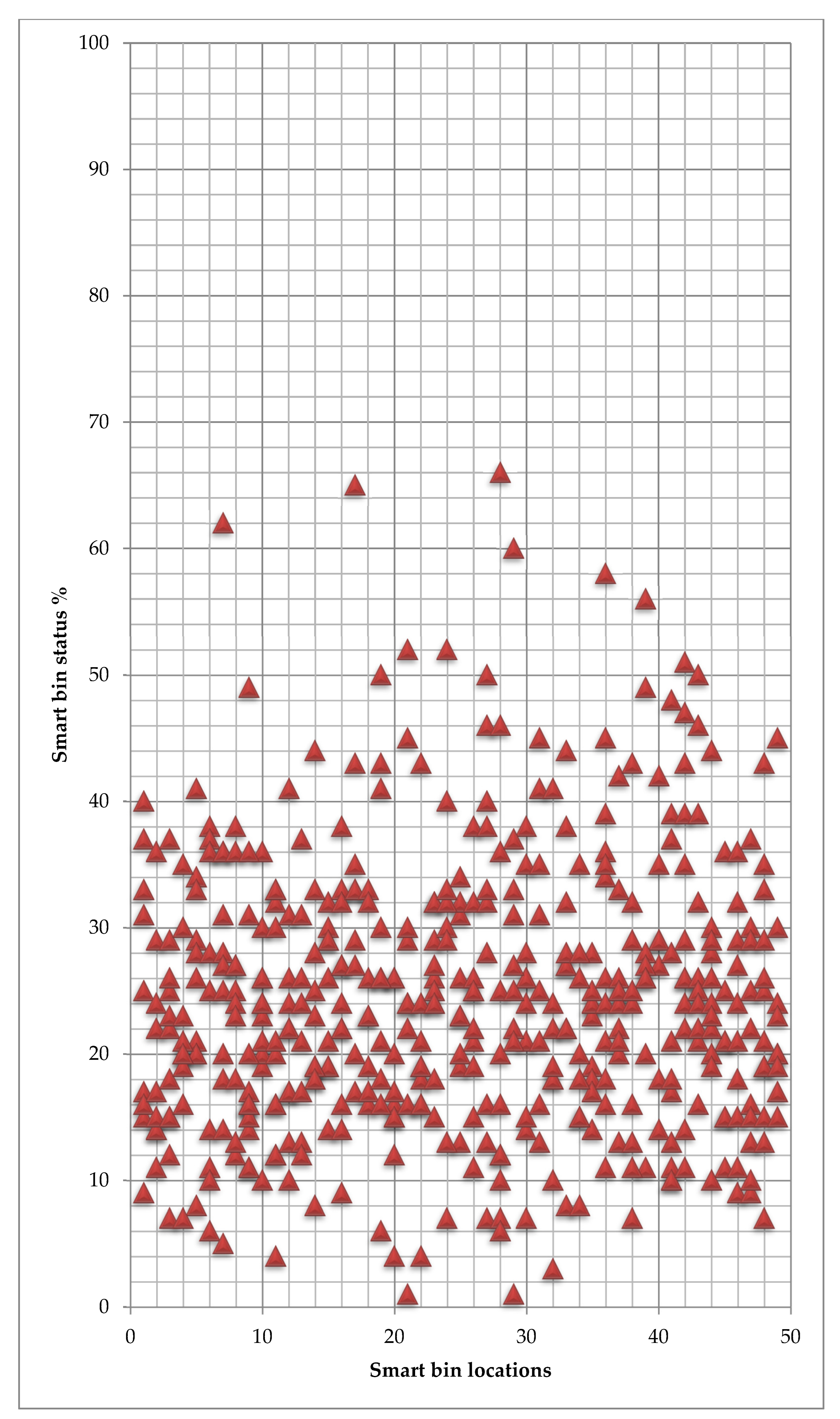

| District/حي | Groceries | Bakeries | Restaurants | Hospitals | Pharmacies |
|---|---|---|---|---|---|
| Al-Misfalah المسفلة | 57 | 8 | 31 | 1 | 5 |
| Al-Rusifia الرصيفية | 32 | 3 | 32 | 4 | 8 |
| Al-Khaldiyeh الخالدية | 50 | 3 | 25 | 10 | 15 |
| Al-Taqwa التقوى | 28 | 1 | 17 | 0 | 8 |
| Al-Hindawiyah الهنداوية | 35 | 2 | 16 | 1 | 4 |
| Al-Rawaby الروابي | 7 | 0 | 6 | 0 | 0 |
| KDE كدي | 14 | 3 | 10 | 1 | 2 |
| Parameter | Description |
|---|---|
| Bin_id | Every smart bin has a unique ID, including the district area |
| waste_type | For sorted waste (Organic, Solid, Liquid, etc.) |
| residual free space | The free space in the container |
| location | the location through GPS |
| waste priority value | The danger of waste has high priority |
| Parameter | Description |
|---|---|
| Truck_id | Every smart bin has a unique ID, including the district area |
| waste_type | For sorted waste (Organic, Solid, Liquid, etc.) |
| residual free space | The free space in the container |
| location | the location through GPS |
| waste priority value | The danger of waste has high priority |
| Next_target_point | The location of the next smart bin that needs cleaning |
| Smart Bin Number | Locations toward Smart Bin | Average of Total Free Space |
|---|---|---|
| 1 | 48 1 | 20 |
| 2 | 15 2 | 16 |
| 3 | 48 3 | 16 |
| 4 | 37 4 | 14 |
| 5 | 37 28 5 | 20 |
| 7 | 15 7 | 8 |
| 9 | 14 9 | 16 |
| 10 | 14 10 | 14 |
| 11 | 31 11 | 4 |
| 12 | 37 25 12 | 12 |
| 13 | 15 13 | 8 |
| 18 | 48 18 | 16 |
| 19 | 48 19 | 18 |
| 20 | 14 20 | 14 |
| 22 | 14 22 | 8 |
| 23 | 31 23 | 16 |
| 24 | 14 24 | 14 |
| 25 | 37 25 | 12 |
| 26 | 26 | 12 |
| 27 | 14 27 | 14 |
| 28 | 15 28 | 10 |
| 29 | 37 29 | 6 |
| 32 | 32 | 18 |
| 33 | 14 33 | 8 |
| 34 | 15 34 | 14 |
| 35 | 15 35 | 10 |
| 36 | 34 36 | 20 |
| 38 | 48 18 38 | 20 |
| 40 | 31 40 | 4 |
| 41 | 15 41 | 2 |
| 43 | 31 43 | 6 |
| 45 | 48 45 | 18 |
| 46 | 37 46 | 4 |
| 47 | 15 47 | 20 |
| 48 | 48 | 16 |
| 49 | 15 49 | 4 |
| Total number of smart bins in need of urgent cleaning | 36 | |
| Smart Bin Number | Locations toward Smart Bin | Smart Bin Waste Status |
|---|---|---|
| 28 | 19 20 30 14 28 | 100 |
| 29 | 11 40 43 29 | 100 |
| 11 | 23 38 18 16 26 11 | 98 |
| 19 | 29 8 37 19 | 98 |
| 43 | 14 20 13 5 45 43 | 98 |
| 17 | 6 49 18 42 17 | 96 |
| 18 | 38 35 21 18 | 96 |
| 13 | 35 12 13 | 94 |
| 16 | 21 18 3 16 | 94 |
| 40 | 35 14 38 40 | 94 |
| 48 | 21 30 48 | 94 |
| 4 | 32 12 27 4 | 92 |
| 14 | 29 43 31 14 | 92 |
| 39 | 37 22 30 9 39 | 92 |
| 9 | 26 40 2 9 | 90 |
| 27 | 29 33 4 27 | 90 |
| 21 | 26 42 10 6 18 21 | 88 |
| 37 | 48 34 3 37 | 88 |
| 21 | 48 41 46 21 | 86 |
| 36 | 27 41 36 | 86 |
| 42 | 18 25 12 42 | 86 |
| 5 | 6 48 1 5 | 84 |
| 8 | 38 17 36 8 | 84 |
| 10 | 38 40 10 | 84 |
| 15 | 16 36 15 | 84 |
| 38 | 11 4 1 38 | 84 |
| 49 | 20 10 49 | 84 |
| 6 | 18 10 6 | 82 |
| 7 | 35 37 3 7 | 82 |
| 24 | 14 20 47 24 | 82 |
| 30 | 49 3 7 21 30 | 80 |
| 32 | 27 14 38 32 | 80 |
| 46 | 16 24 5 46 | 80 |
| Total number of routes toward the urgent bins | 33 | |
| Smart Bin Number | Locations toward Smart Bin | Smart Bin Waste Status |
|---|---|---|
| 28 | 19 20 30 14 28 | 100 |
| 29 | 11 40 43 29 | 100 |
| 17 | 6 49 18 42 17 | 96 |
| 13 | 35 12 13 | 94 |
| 16 | 21 18 3 16 | 94 |
| 48 | 21 30 48 | 94 |
| 4 | 32 12 27 4 | 92 |
| 39 | 37 22 30 9 39 | 92 |
| 21 | 48 41 46 21 | 86 |
| 36 | 27 41 36 | 86 |
| 42 | 18 25 12 42 | 86 |
| 5 | 6 48 1 5 | 84 |
| 8 | 38 17 36 8 | 84 |
| 10 | 38 40 10 | 84 |
| 15 | 16 36 15 | 84 |
| 7 | 35 37 3 7 | 82 |
| 24 | 14 20 47 24 | 82 |
| Total number of routes to toward the urgent bins | 17 | |
Publisher’s Note: MDPI stays neutral with regard to jurisdictional claims in published maps and institutional affiliations. |
© 2022 by the authors. Licensee MDPI, Basel, Switzerland. This article is an open access article distributed under the terms and conditions of the Creative Commons Attribution (CC BY) license (https://creativecommons.org/licenses/by/4.0/).
Share and Cite
Abdullah, N.; Al-wesabi, O.A.; Mohammed, B.A.; Al-Mekhlafi, Z.G.; Alazmi, M.; Alsaffar, M.; Baklizi, M.; Sumari, P. IoT-Based Waste Management System in Formal and Informal Public Areas in Mecca. Int. J. Environ. Res. Public Health 2022, 19, 13066. https://doi.org/10.3390/ijerph192013066
Abdullah N, Al-wesabi OA, Mohammed BA, Al-Mekhlafi ZG, Alazmi M, Alsaffar M, Baklizi M, Sumari P. IoT-Based Waste Management System in Formal and Informal Public Areas in Mecca. International Journal of Environmental Research and Public Health. 2022; 19(20):13066. https://doi.org/10.3390/ijerph192013066
Chicago/Turabian StyleAbdullah, Nibras, Ola A. Al-wesabi, Badiea Abdulkarem Mohammed, Zeyad Ghaleb Al-Mekhlafi, Meshari Alazmi, Mohammad Alsaffar, Mahmoud Baklizi, and Putra Sumari. 2022. "IoT-Based Waste Management System in Formal and Informal Public Areas in Mecca" International Journal of Environmental Research and Public Health 19, no. 20: 13066. https://doi.org/10.3390/ijerph192013066
APA StyleAbdullah, N., Al-wesabi, O. A., Mohammed, B. A., Al-Mekhlafi, Z. G., Alazmi, M., Alsaffar, M., Baklizi, M., & Sumari, P. (2022). IoT-Based Waste Management System in Formal and Informal Public Areas in Mecca. International Journal of Environmental Research and Public Health, 19(20), 13066. https://doi.org/10.3390/ijerph192013066








